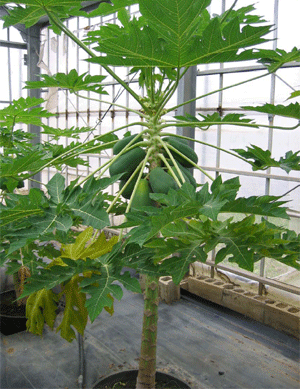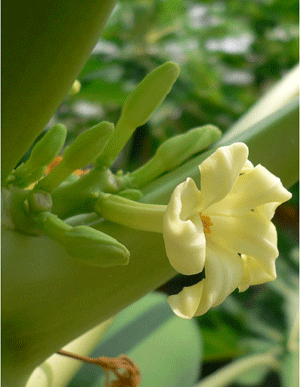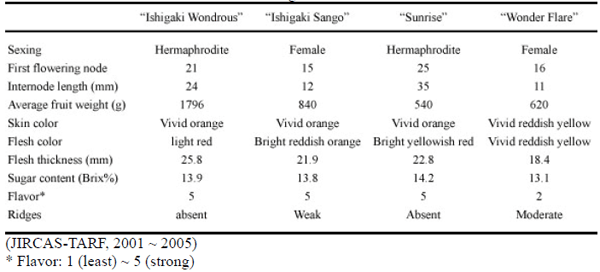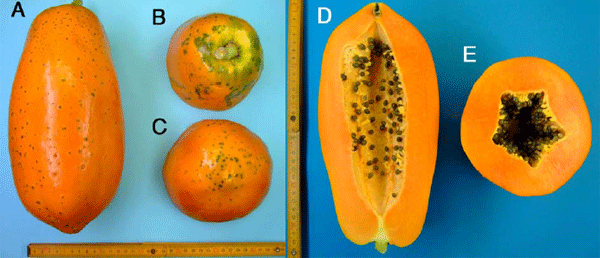“Ishigaki Wondrous”- A new variety of semi dwarf papaya with larger fruits and high quality
Description
Papaya (Carica papaya L.) is one of the most widely grown fruit crops in the tropics and subtropics. In Japan, papaya is produced in the southernmost region of Japan from southern Kyushu to Okinawa. The unripe fruit is also consumed as a vegetable aside from the ripe fruit which is a table fruit. The “Sunrise” fruit-type family is highly regarded both globally and in the Japanese market. However, this family takes the form of relatively tall trees, and at high temperatures, fruit abscission occurs due to male sterility. These two characteristics constrain papaya production in Japan’s growing area in both summer, when temperatures are high, and autumn, due to frequent typhoons. We therefore embarked on a program to breed a new heat-tolerant dwarf papaya tree for sub-tropical regions, with fruit quality equal to or better than the “Sunrise” family fruit.
A new variety, “Ishigaki Wondrous,” was discovered by chance from a seedling of “Wonder Bright” in 1997. We planted it together with other crossed seedlings in 1998 and selected it as a promising tree in 2000. The selections were made of the plants showing high fruit quality, early bearing and shorter lengths of the internodes. Between 2001 to 2008, it had been subjected to the same characteristic tests as “Ishigaki 1.”In 2009, we applied to Japan’s Ministry of Agriculture, Forestry and Fisheries for the registration of this new variety.
“Ishigaki Wondrous” is a hermaphrodite plant and has a semidwarf tree form (Fig. 1, 2). The type of flowering is only inflorescences. The number of nodes from the ground to the first flowering node is 21 and smaller than the 25 seen in “Sunrise”. The length of each internode is 24 mm, much shorter than the 35 mm seen in “Sunrise” (Table 1). Therefore, “Ishigaki Wondrous” can be easily harvested for a considerably long time due to its lower height. The average size of leaves is the same as the common papaya and the tertiary lobe is absent in its leaf blade. Furthermore, there is no anthocyanin coloration in the petiole.
The fruit is obovoid-shaped and the average weight is 1,796 g (Table 1 and Fig. 3). Fruit enlargement is affected by the season and the range of fruit weight is from 1,515 g to 2,124 g. The skin color of the ripe fruit is vivid orange (Japanese Horticultural Plant Standard Color Chart: No. 1605) and the flesh is light red (No. 0713). The fruit has no ridges and the flesh thickness is 25.8 mm, much thicker than other varieties. Thus, “Ishigaki Wondrous” is easier to handle for peeling. The average sugar content is 13.9% on Brix. It is much higher than that of “Wonder Flare”, the most important dwarf variety cultivated in the island of Ishigaki, and approximately the same as that of “Sunrise” and “Ishigaki Sango”, a heat-tolerant dwarf variety developed at JIRCAS. Aside from being very sweet, the flavor and taste are excellent.
The average period from planting to first flowering is 100 days. “Ishigaki Wondrous” is able to produce fruits throughout the year. But a few flower abscissions occur due to male sterility under high temperature. Hand pollination with the pollens of a male flower is necessary to prevent it.
Figure, table
-
Fig. 1. Fruiting of the “Ishigaki Wondrous” potted tree. -
Fig. 2. Flowering of “Ishigaki Wondrous” -
-
Fig. 3. Fruit of “Ishigaki Wondrous”.
A: Whole fruit side view, B: Stem end, C: Fruit apex, D: Longitudinal cross section, E: Transverse cross section.
- Affiliation
-
Japan International Research Center for Agricultural Sciences Tropical Agriculture Research Front
- Classification
-
Research A
- Term of research
-
FY2008(FY1997~2005、FY2006~2010)
- Responsible researcher
-
FUKAMACHI Hiroshi ( Institute of Fruit Tree Science, NARO )
KATO Hidenori ( Tropical Agriculture Research Front )
HIDAKA Tetsushi ( Tropical Agriculture Research Front )
TAMASHIRO Masao ( Ishigaki-Island Papaya )
OGAWA Kazunori ( Institute of Fruit Tree Science, NARO )
KOMORI Sadao ( Iwate University )
FUSHIMI Tsutomu ( Tropical Agriculture Research Front )
- ほか
- Publication, etc.
-
Application number of variety registration : no. 23577.
- Japanese PDF
-
2009_seikajouhou_A4_ja_Part4.pdf334.49 KB




